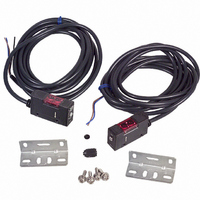E3S-AT61 Omron, E3S-AT61 Datasheet - Page 24

E3S-AT61
Manufacturer Part Number
E3S-AT61
Description
Photoelectric Sensor
Manufacturer
Omron
Series
E3S-Ar
Type
Photoelectric Sensorr
Specifications of E3S-AT61
Output Current
100mA
Sensor Output
NPN
Supply Voltage Range Dc
10V To 30V
Sensor Housing
Rectangular
Output Type
Transistor
Sensor Input
Optical
Sensing Range Max
7m
Mounting Type
Bracket
Sensing Distance
275.591" (7m)
Sensing Method
Through-Beam
Output Configuration
NPN - Dark-ON/Light-ON - Selectable
Current - Supply
40mA
Voltage - Supply
10 V ~ 30 V
Response Time
0.5ms
Package / Case
Module, Pre-Wired
Features
Control the laser with digital fiber amplifier
Height
21 mm
Length
45.3 mm
Maximum Operating Temperature
+ 55 C
Minimum Operating Temperature
- 25 C
Operating Supply Voltage
10 V to 30 V
Width
12.4 mm
Lead Free Status / RoHS Status
Lead free / RoHS Compliant
Lead Free Status / RoHS Status
Lead free / RoHS Compliant, Contains lead / RoHS compliant by exemption
Other names
E3SAT61
OR586
OR586
Available stocks
Company
Part Number
Manufacturer
Quantity
Price
Company:
Part Number:
E3S-AT61
Manufacturer:
OMRON
Quantity:
384
Power Supply
When using a commercially available switching regulator, ground the
FG (frame ground) and G (ground) terminals.
If not grounded, switching noise in the power supply may cause
malfunction.
Example of Connection with S3D2 Sensor Controller
DC Three-wire NPN Output Sensors
Reverse operation is possible using the signal input switch on the
S3D2.
http://www.ia.omron.com/
Blue 0 V
Black OUT
Brown +12 V
S3D2
10
7
4
1
11
8
5
2
12
9
6
3
Photoelectric Sensors Technical Guide
● Mounting
Attachment to Moving Parts
To mount the Photoelectric Sensor to a moving part, such as a robot
hand, consider using a Sensors that uses a bending-resistant cable
(robot cable).
Although the bending repetition tolerance of a standard cable is
approximately 13,000 times, robot cable has an excellent bending
tolerance of approximately 500,000 times.
Cable Bending Destruction Test (Tough Wire Breaking
Test)
With current flowing, bending is repeated to check the number of
bends until the current stops.
The testing conditions of the standard cable and robot cable are
different.
Refer to the values in the above table to check bend-resistant
performance under actual working conditions.
Test
Result
(c)Copyright OMRON Corporation 2008 All Rights Reserved.
Bending
angle (θ)
Bending
repetitions
Weight
Operation
per bending
Bending
radius of
support
points (R)
Specimen
Approx. 13,000 times
Left/right 90° each
VR (H) 3 x18/0.12
(1) through (3) in
(1)
Standard cable
figure once
5 mm
300g
R
---
θ
(2)
θ
Weight
conductive electrical wire
Approx. 500,000 times
(3)
2 x 0.15 mm
Robot cable: Strong,
Left/right 45° each
60 bends/minute
(1) through (3) in
figure once
2.5 mm
200g
2
, shielded
C-4











